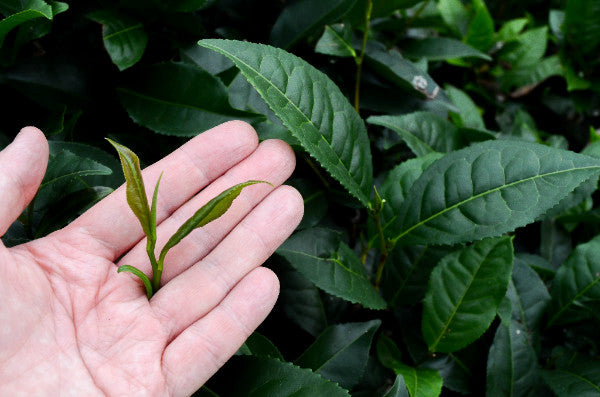|
I’m frequently asked how much caffeine is in the teas we sell. This leads to a lengthy “it depends” description of the variables that affect caffeine levels. March is Caffeine Awareness Month so I thought it was a good time to explain how caffeine levels in your tea cup vary and the reasons why questions about caffeine are difficult to answer:
Turn over a new leaf: caffeine is a defence mechanism for the Camellia Sinensis plant. It’s a naturally occurring insect repellent that kills bugs when they attempt to feed on new buds and young leaves, so buds and first leaf generally have slightly more caffeine than leaves picked from the lower part of the tea bush. A black tea with lots of golden tips or a white tea that is all buds could have more caffeine, but how much is in your cup depends on how the tea is brewed.
Not everything is black and white: oxidation does not increase the amount of caffeine in tea. The greatest impact on caffeine content in your cup is the water temperature and length of steeping time. A tea steeped for five minutes at 95C will likely transfer more caffeine to the cup than a tea steeped for two minutes at 80C, depending on how much tea is used and the varietal it came from.
Size matters: on average, tea leaves contain 3% caffeine by weight, although this can range from 1.4% to 4.5%. Typically, the leaves from Camellia Sinensis Assamica varietal have higher caffeine levels than the small leaves from Camellia Sinensis var Sinensis. This makes sense when you consider one has more surface area than the other. But if you’re weighing 3 grams of tea to brew you might find teas from the Assamica varietal are heavier, like a semi-ball rolled Taiwanese oolong, compared to a First Flush Darjeeling that comes from the Sinensis varietal. One teaspoon of oolong vs. two teaspoons of Darjeeling so you are using less total tea leaves even though the weight is the same. So which tea results in more caffeine in your cup? Like I said, it depends.
So happy together
Where on the plant the leaves come from, how you’re brewing the tea, the tea plant varietal and how much tea you’re using – and we haven’t even touched on other factors that determine the caffeine content in the dry leaf such as soil chemistry, altitude, cultivation practices and withering. Regardless of how much caffeine is in your tea cup, the good news is it’s not alone.
L-theanine is a naturally occurring amino acid in tea leaves and this relaxant reduces your heart rate and blood pressure, while improving energy and focus. Caffeine is a stimulant and it can do the opposite by increasing your heart rate and blood pressure, and it can make you feel jittery and anxious which affects your concentration. But together they create a synergy that reduces negative effects and brings out the best in each other.
A vasoconstrictor is a substance that makes your blood vessels smaller which can temporarily increase your blood pressure. Caffeine acts as a vasoconstrictor and studies have shown that L-theanine helped to reduce the effects caffeine has on blood pressure and heart rate when by itself. Studies also found that together these two substances improved mood, memory and cognitive performance.
L-theanine promotes alpha brain waves giving you a relaxed feeling. Together with the beneficial effects of improved concentration and attention from caffeine, another study showed that L-theanine provided balance for the brain to avoid possible jitters from caffeine and suggested it might interact with caffeine to improve mental performance. So you achieve more, feel better and have a relaxed focus. More reasons to love tea.
So when you find your cup of tea to be calming even though it is caffeinated, you’ll know you’re enjoying the benefits of a synergistic relationship.
|


Leave a comment